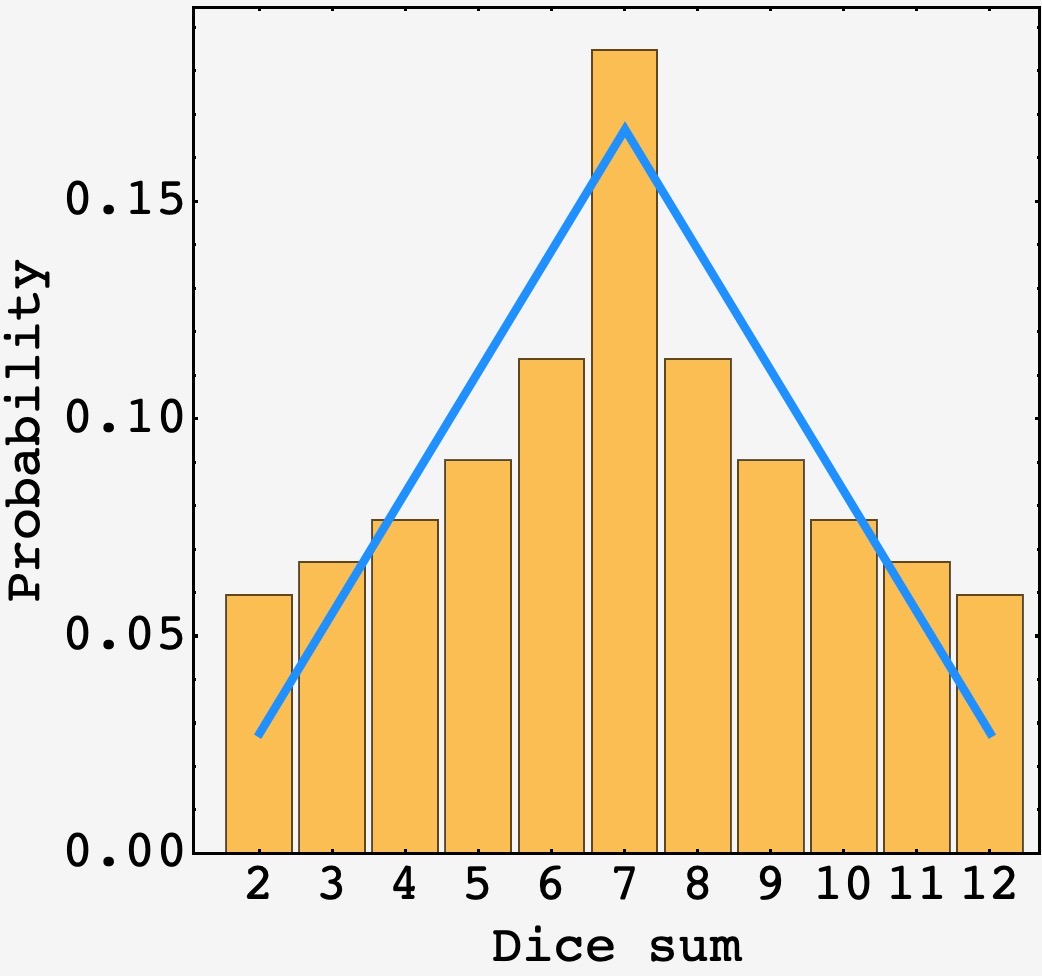Question: When you roll a pair of fair dice, the most likely outcome is $7$ (which occurs $1/6^\text{th}$ of the time) and the least likely outcomes are 2 and 12 (which each occur $1/36^\text{th}$ of the time).
Annoyed by the variance of these probabilities, I set out to create a pair of “uniform dice.” These dice still have sides that are uniquely numbered from $1$ to $6,$ and they are identical to each other. However, they are weighted so that their sum is more uniformly distributed between $2$ and $12$ than that of fair dice.
Unfortunately, it is impossible to create a pair of such dice so that the probabilities of all $11$ sums from $2$ to $12$ are identical (i.e., they are all $1/11$). But I bet we can get pretty close.
The variance of the $11$ probabilities is the average value of the squared difference between each probability and the average probability (which is, again, $1/11$). One way to make my dice as uniform as possible is to minimize this variance.
So how should I make my dice as uniform as possible? In other words, which specific weighting of the dice minimizes the variance among the $11$ probabilities? That is, what should the probabilities be for rolling $1, 2, 3, 4, 5$ or $6$ with one of the dice?
Solution
The unusual goal before us is to make the odds of each sum as uniform as we can. We want the odds to roll $1+1=2$ as close to the odds of $1+6=2+5=3+4=7$ as possible.
So we are interested in the variance of the probability of a pair of dice appearing which, as a subtask, entails finding the expectation value of the probability of a pair of dice appearing!
The second part is easy. Since $\sum_i p_i = 1,$ and there are $11$ possible outcomes for two dice, we get $\langle p\rangle = \frac{1}{11}.$
Add it up
The first part is a little spicy.
We are looking at the sum
\[\sigma^2(p) = \frac{1}{11} \sum_s \left(\sum_{\{i+j = s\}} p_i p_j - \langle p\rangle\right)^2\]They start out simple — consider the $\left(1,1\right)$ outcome, which has probability $p_1^2.$ But by the $6$, which can come out one of five ways
\[P(\text{dice sum} = 6) = p_1p_5 + p_2p_4 + p_3^2 + p_4p_2 + p_5p_1,\]we have a mess on our hands.
Slim it down
Adding it up, this generates a big polynomial that we have to minimize.
On its face this has six variables, $\{p_i\}_{i=1}^6,$ but, happily, a moment’s thought can reduce it to three.
The variables describing sides $1, 2,$ and $3$ are symmetric with the variables describing sides $4, 5,$ and $6,$ respectively, so we can replace $p_4\rightarrow p_1, p_5\rightarrow p_2,$ and $p_6\rightarrow p_3.$
Putting it all together, we have the code below
ps = {p1, p2, p3, p4, p5, p6};
Z =
Sum[
ps[[i]] ps[[j]] z^(i + j)
, {i, 1, 6}
, {j, 1, 6}
] /. {p6 -> p1, p5 -> p2, p4 -> p3}
coefficients = CoefficientList[Z, z][[3 ;; -1]]
mean = 1/11
variance =
1/11 Sum[(coefficients[[i]] - mean)^2, {i, 1, Length@coefficients}]
solution = NMinimize[
{variance,
{ 0 <= p1 <= 1/2
, 0 <= p2 <= 1/2
, 0 <= p3 <= 1/2
, p1 + p2 + p3 == 1/2
}
}
, {p1, p2, p3}
]
which shows that the minimum variance is $\sigma^2_\text{min}\approx 0.00121758$ which is realized by assigning $p_1=p_6=0.243883,$ $p_2=p_5\approx 0.137479,$ and $p_3=p_4\approx 0.118638.$
This produces the following distribution for the dice sum probabilities:
The yellow bars show the minimal variance distribution, and the blue curve shows the distribution for regulation die.
As expected, the distribution is symmetric about $7.$
For posterity, the approximate numerical values are:
\[\begin{array}{c|l} \text{Dice sum} & \text{Probability} \\ \hline 2 & 0.0594787 \\ 3 & 0.0670576 \\ 4 & 0.0767681 \\ 5 & 0.0904881 \\ 6 & 0.113753 \\ 7 & 0.184909 \\ 8 & 0.113753 \\ 9 & 0.0904881 \\ 10 & 0.0767681 \\ 11 & 0.0670576 \\ 12 & 0.0594787 \end{array}\]